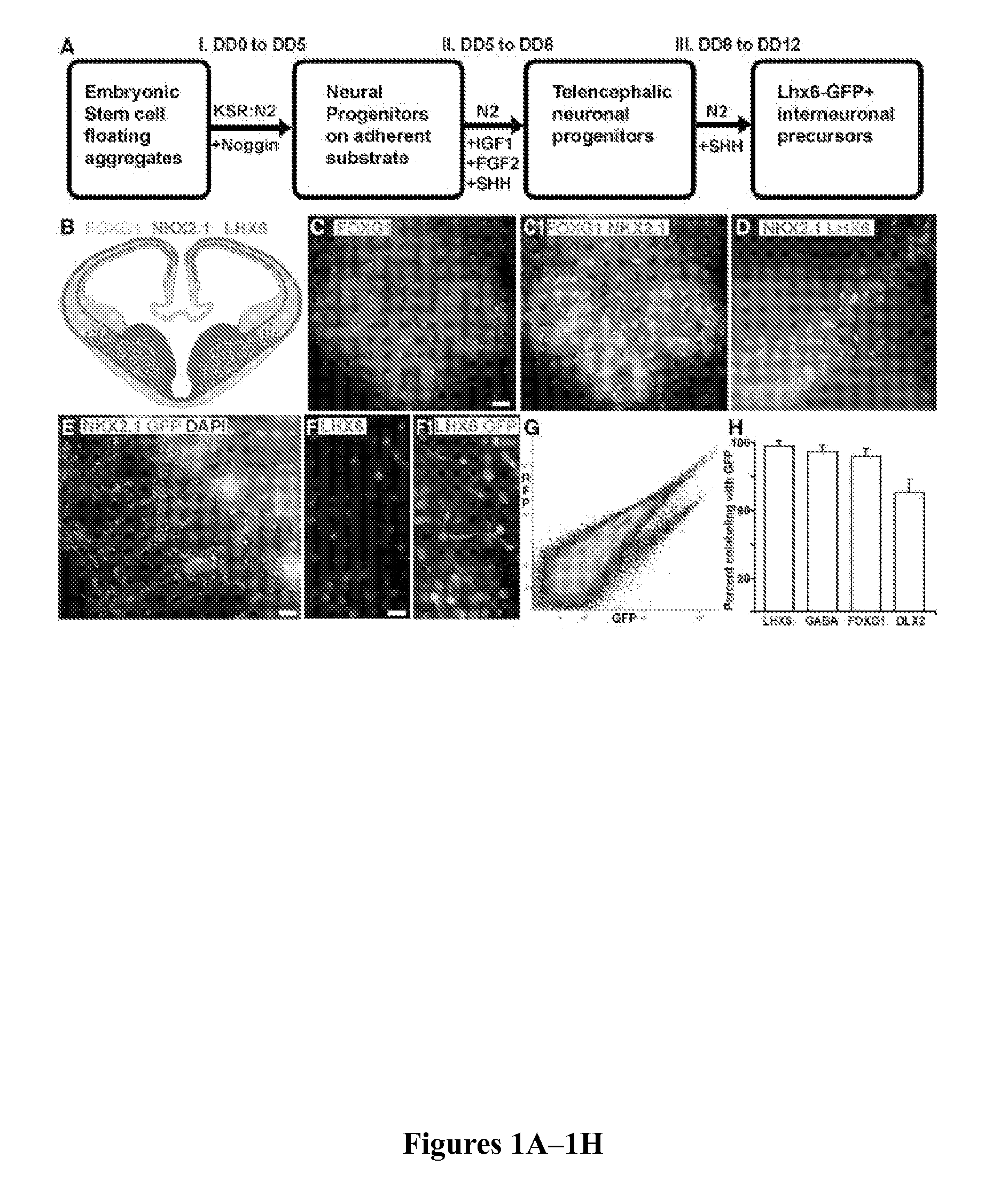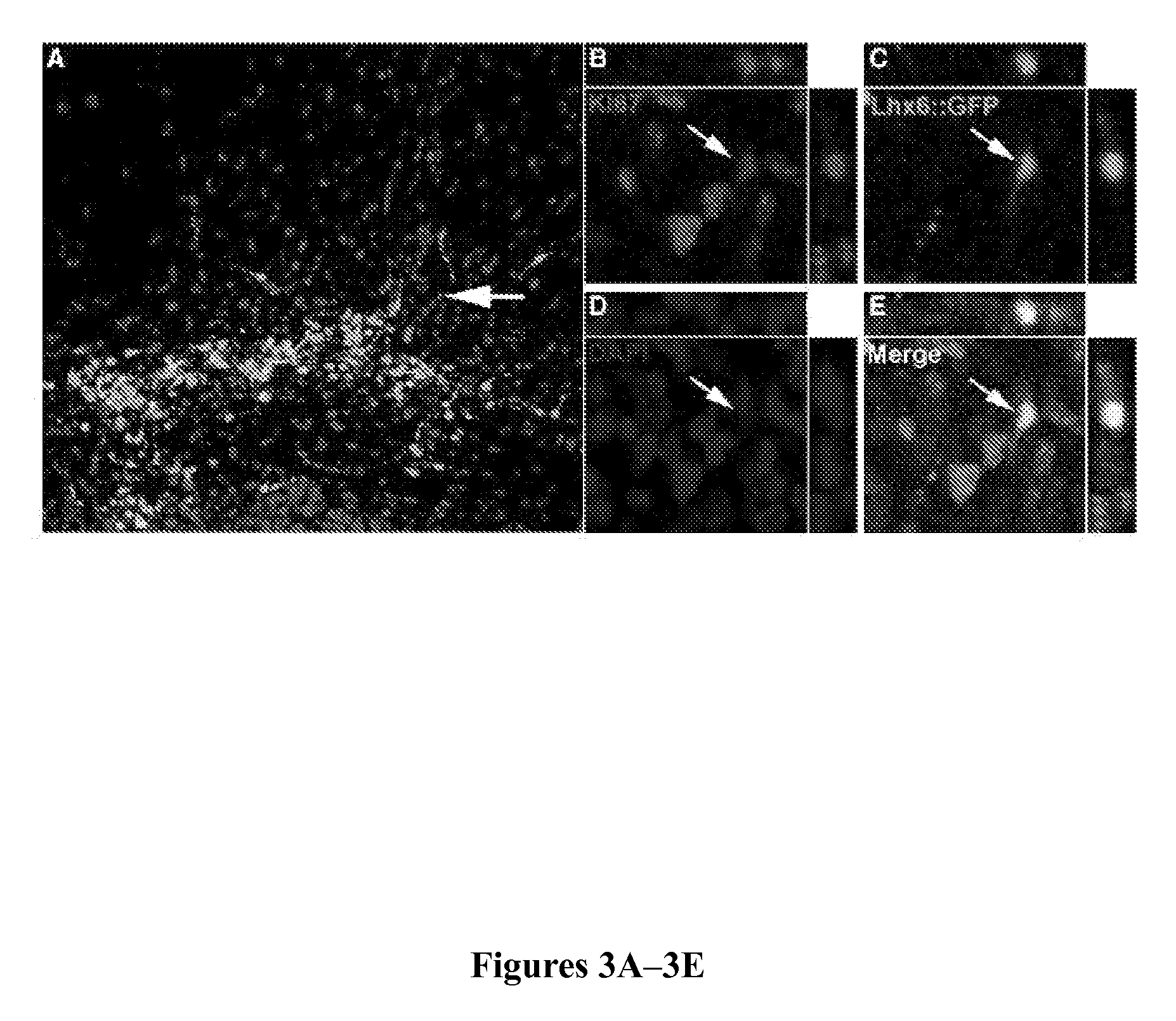Method to isolate, identify, and use embryonic stem cells directed to forebrain interneuron fate
- Summary
- Abstract
- Description
- Claims
- Application Information
AI Technical Summary
Benefits of technology
Problems solved by technology
Method used
Image
Examples
example 1
Generation of Mouse Embryonic Stem Cell-Derived Interneuronal Precursors
[0090]Previous work has demonstrated that ESCs can be directed toward telencephalic progenitors, including those that differentiate into neurons expressing the generally inhibitory neurotransmitter GABA (Watanabe et al., “Directed Differentiation of Telencephalic Precursors From Embryonic Stem Cells,”Nat Neurosci 8(3):288 (2005) and Gaspard et al., “An Intrinsic Mechanism of Corticogenesis From Embryonic Stem Cells,”Nature 455(7211):351 (2008), which are hereby incorporated by reference in their entirety). Since FoxG1+ and Nkx2.1+ progenitors give rise both to GABAergic interneurons and projection neurons (Fogarty et al., “Spatial Genetic Patterning of the Embryonic Neuroepithelium Generates GABAergic Interneuron Diversity in the Adult Cortex,”J Neurosci 27(41):10935 (2007) and Xu et al., “Fate Mapping Nkx2.1-Lineage Cells in the Mouse Telencephalon,”J Comp Neurol 506(1):16 (2008), which are hereby incorporated ...
example 2
Transplantation, Migration and Survival of Lhx6::GFP Cells
[0094]To characterize the fate potential of the Lhx6::GFP line, cells were differentiated for 11 days (FIG. 1A), collected by FACS for GFP expression (FIG. 1G), and transplanted into neonatal mouse cortex. Medial ganglionic eminence (MGE)-derived progenitors transplanted into both neonatal and adult mouse cortex have been shown to migrate, survive, and differentiate into several subgroups of cortical interneurons (Wichterle et al., “Young Neurons From Medial Ganglionic Eminence Disperse in Adult and Embryonic Brain,”Nature Neuroscience 2(5):461 (1999); Cobos et al., “Mice Lacking Dlx1 Show Subtype-Specific Loss of Interneurons, Reduced Inhibition and Epilepsy,”Nat Neurosci 8(8):1059 (2005); Wonders et al., “A Spatial Bias for the Origins of Interneuron Subgroups Within the Medial Ganglionic Eminence,”Dev Biol 314(1):127 (2008); Alvarez-Dolado et al., “Cortical Inhibition Modified by Embryonic Neural Precursors Grafted into th...
example 3
Cortical Interneuron-Like Differentiation of Lhx6::GFP Cells
[0097]Extensive migration after transplantation into neonatal cortex is highly similar to that previously reported for MGE-derived interneuron progenitors (Wonders et al., “A Spatial Bias for the Origins of Interneuron Subgroups Within the Medial Ganglionic Eminence,”Dev Biol 314(1):127 (2008) and Alvarez-Dolado et al., “Cortical Inhibition Modified by Embryonic Neural Precursors Grafted into the Postnatal Brain,”J Neurosci 26(28):7380 (2006), which are hereby incorporated by reference in their entirety). To determine whether ESC-derived cells acquire neurochemical characteristics of cortical interneurons, transplanted Lhx6::GFP cells were examined by immunofluorescence for interneuron markers at 30 and 65 DPT (FIG. 5). Like MGE-derived cortical interneurons, most GFP+ cells expressed GABA (FIGS. 5B and 5B1; n=5; 161 / 189; 85.7%+ / −3.5%), as well as the subgroup-specific markers parvalbumin (PV) or somatostatin (Sst) (FIGS. 5...
PUM
| Property | Measurement | Unit |
|---|---|---|
| doubling time | aaaaa | aaaaa |
| resting membrane potential | aaaaa | aaaaa |
| resting membrane potential | aaaaa | aaaaa |
Abstract
Description
Claims
Application Information
 Login to View More
Login to View More - R&D
- Intellectual Property
- Life Sciences
- Materials
- Tech Scout
- Unparalleled Data Quality
- Higher Quality Content
- 60% Fewer Hallucinations
Browse by: Latest US Patents, China's latest patents, Technical Efficacy Thesaurus, Application Domain, Technology Topic, Popular Technical Reports.
© 2025 PatSnap. All rights reserved.Legal|Privacy policy|Modern Slavery Act Transparency Statement|Sitemap|About US| Contact US: help@patsnap.com



